Cassava infected with mosaic leaves, still good
Most farmers think that cassava is an easy crop to grow, so investment in intensive farming is small and does not focus on irrigation for cassava. Therefore, the poor soil for cassava becomes increasingly poor in nutrients and leads to lower and lower productivity. This is not the case in Tay Ninh. With rich farming experience and the application of scientific and technical advances in production, especially, 100% of cassava cultivation households have installed automatic irrigation systems, so although the cassava leaf mosaic disease is complicated, the cassava yield here is still over 30 tons/ha reached.
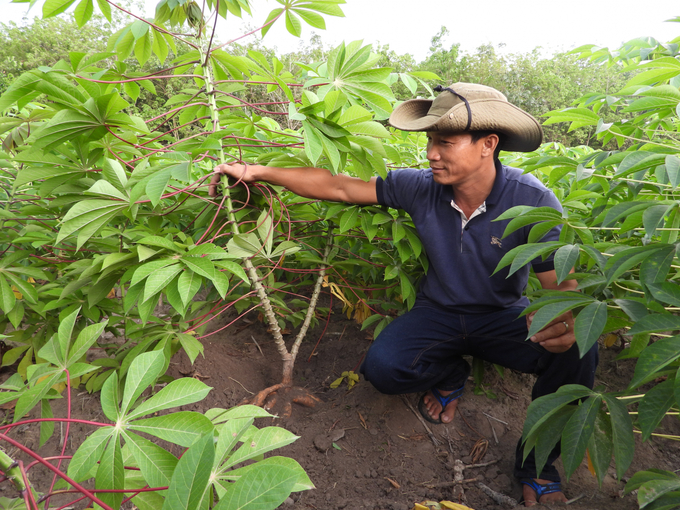
Mr. Bui Cong Ngoc in his cassava garden. Picture: Hong Kong Thuy.
With 150 ha of cassava, Mr. Bui Cong Ngoc lives in Tan Truong Hamlet, Tan Hiep Township, Tan Chau District and is a typical cassava farmer in Tay Ninh Province.
When visiting Mr. Ngoc’s cassava farm and looking at the large and strong cassava plants, few people think that these are the varieties that have been infected with mosaic disease but are still growing and developing well. Tried a cassava root, the bulbous clumps are large and numerous and estimated to weigh in excess of 5kg.
When the weather and climate become more and more unpredictable, strange pests and diseases appear, it takes a lot of flour to sell cassava at a good price. Mr. Ngoc has spent a lot of time learning effective cassava cultivation techniques from the mass media and informational materials, and has even traveled to Thailand to learn from experiences.
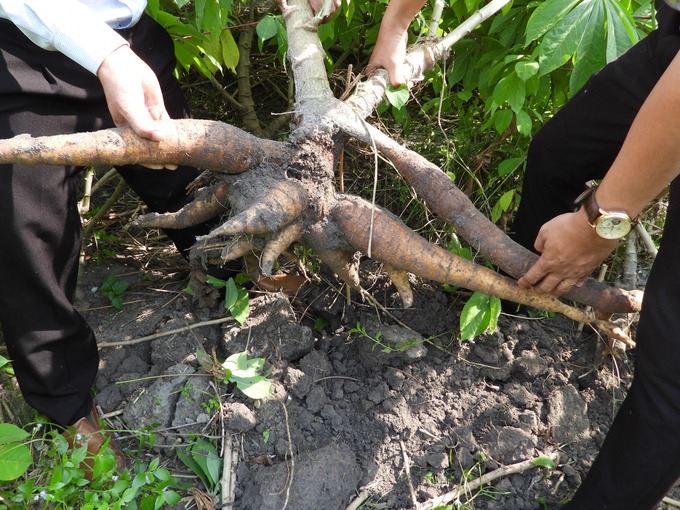
Although infected with leaf mosaic, cassava still delivers a high yield thanks to intelligent cultivation methods. Picture: Hong Kong Thuy.
Accordingly, he noted that cassava is a plant with heavy nutrient uptake from the soil, so fertilizing and adding nutrients to the soil is imperative if you don’t want the soil to deteriorate quickly. Unlike many others, Mr. Ngoc limited the use of chemical fertilizers and instead used organic fertilizers, organic microorganisms. At the same time, he used the rotation method to improve the soil and grew many different crops such as corn and peanuts, not just monocultures of cassava.
“Diversity is also a key factor in cassava yield. Currently, I hold the KM419 variety in high esteem as it has many outstanding advantages over other cassava varieties. This variety gives tubers with high starch content (average 28-30%) when grown on hilly soil, average yield is 40-45 tons/ha, powder content is 25-26%, slightly higher than many others Varieties of cassava, “Mr. Sharing.
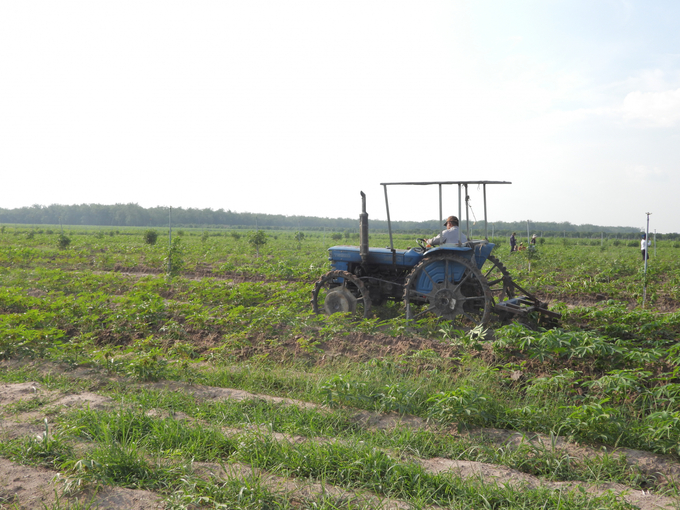
The technique of mulching like planting potatoes and sowing cuttings vertically in Mr. Bui Cong Ngoc’s replanting garden. Picture: Hong Kong Thuy.
Mr Ngoc added that the way cassava is grown is also an important factor that greatly affects yield. When planting, the soil must be carefully cleaned and porous. In addition, he has experimented with many different ways of growing cassava, from traditional lying cuttings to new planting methods using vertical cuttings and slanting cuttings. The results show that each planting method has different effects, with vertical cut planting yielding the highest yield.
“There are many measures to increase cassava yield, such as: “By using high-yielding varieties, mechanizing production, investing in intensive agriculture, irrigation, cassava irrigation is one of the measures that are important to increase the yield and quality of cassava,” Herr said. Added Ngoc.
Number 1 priority for rapid propagation of resistant varieties
Due to his experience in cassava cultivation, Mr. Bui Cong Ngoc is recently the only person selected by Tay Ninh province agricultural sector and research institutes as a partner for trial planting, transfer, seeding and propagation of 2 cassava varieties HN3, HN5. So far, after 8 months of trial planting, 10 ha of his cassava varieties HN3 and HN5 have achieved unexpected results, not only resistant to mosaic diseases, with these varieties achieving a yield of 45-50 tons/ha.
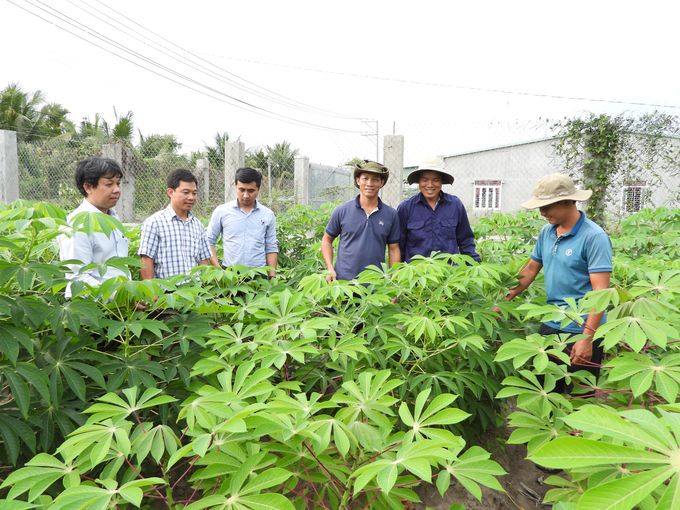
Mr. Bui Cong Ngoc’s 100% mosaic resistant cassava garden. Picture: Hong Kong Thuy.
Mr Ngoc said that the cassava variety determines 30% of the yield, with the remaining 70% due to the cultivation method. Theoretically, the 2 mosaic-resistant cassava varieties HN3, HN5 deliver a yield of 39.4 to 42.6 tons/ha. When grown using smart farming methods, this cassava strain produces an excellent yield. “Through practical tests after 8 months of cultivation, the average yield is 45-50 tons/ha on barren land, if the soil is good and properly cultivated, it will reach over 70 tons/ha,” said Mr. Ngoc excitedly.
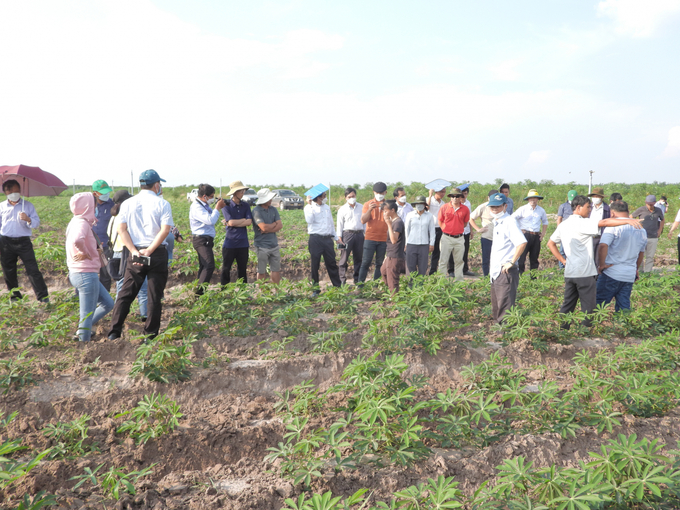
Mr. Bui Cong Ngoc shared his cassava cultivation experience with local and foreign people. Picture: Hong Kong Thuy.
In addition to enriching himself, he lobbied for cassava farmers to set up the Dang Quang Cooperative to not only share mosaic-resistant varieties for the people of the area, but also to sign contracts to support varieties for farming towns to commit in the region.
In addition to propagation using traditional methods, the cooperative is also supported by the International Center for Tropical Agriculture (CIAT) with 3 greenhouses of 40m2 each for greenhouse propagation. Only 50 bunches of cassava seeds propagate 50ha of cassava seedlings after 3 months, currently with 3 greenhouses equivalent to nearly 150ha of seeds.
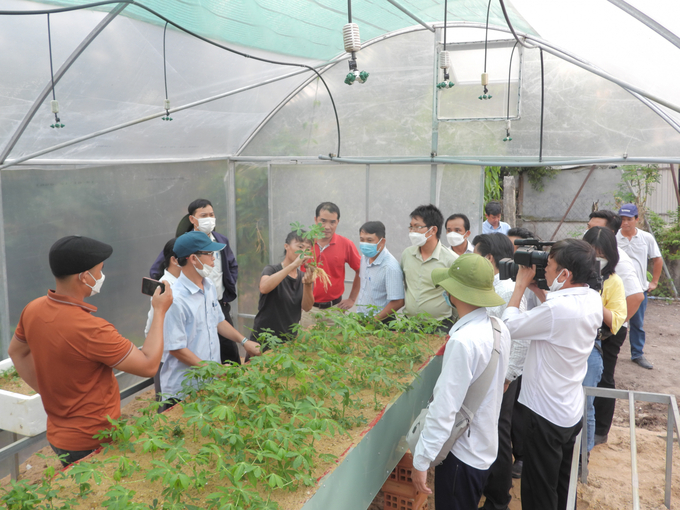
Indoor breeding model at Dang Quang Cooperative. Picture: Hong Kong Thuy.
According to the Ministry of Agriculture and Rural Development of Tay Ninh, covering an area of about 60,000 hectares and an annual production of more than 1.7 million tons, Tay Ninh has always ranked second in area and first in the over the years Cassava production occupied the whole country. Country. As of August 31, 2022, the cassava production area in the province is 53,169 ha, reaching 87.9% of the 2022 plan (60,500 ha); where the 2021-2022 winter-spring harvest is 38,900 ha, the 2022 summer-autumn harvest is 11,850 ha and the 2022 sowing is 2,419 ha.

